The U.S. September 2012 monthly trade deficit declined by -5.1%, or -$2.25 billion. August's trade deficit was revised down by -$427 million, which gives a 3.1% monthly increase instead of the originally reported 4.1%. While the press touts the lowest monthly trade deficit since December 2010, the reality is September gives the second largest China trade deficit in history. To make matters more dramatic, the record $29.4 billion China monthly trade deficit was set just two months ago.
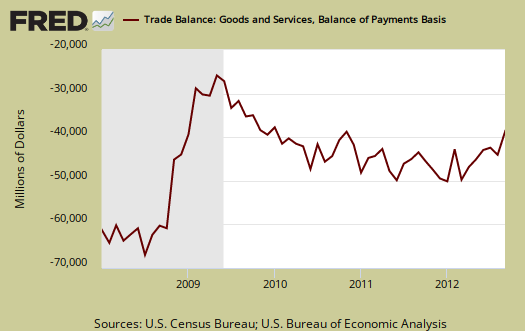
September's exports increased $5.6 billion, or 3.1%. Imports increased by $3.4 billion, or 1.5%.
The three month moving average gives a trade deficit of $42.6 billion and a change of -$119 million, or 0.3%.
The U.S.-China goods trade deficit alone was, $29.1 billion, or 50.2% of the total goods trade deficit and this ratio includes oil, our largest commodity import. The year to date tally of the goods trade deficit with China is $232.18 billion, or 42.0% of the entire goods trade deficit to date. In September 2011, the China goods trade deficit up to that time was $217.43 billion and 39.3% of the total goods trade deficit. This is a year to date increase of 6.8% in the goods trade deficit with China in comparison to 2011. We're well on our way to have an over $300 billion trade deficit with China for 2012, which would be a new record. China's never ending import barrage is highly cyclical as one can see in the below graph of the not seasonally adjusted trade deficit with China and why we compare to this time last year in order to try to remove seasonality.
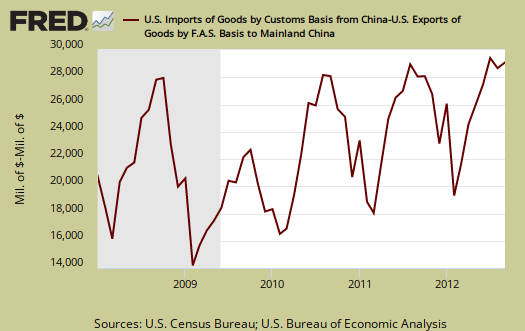
The South Korea-U.S. trade deficit is quickly rising. From January to September 2012 we have a $12.034 billion trade deficit with Korea. The same time period for 2011 shows a $10.110 billion Korean trade deficit, a 19.0% increase. March 15, 2012, the South Korean NAFTA style trade deal went into effect. Below is a graph of the Korean goods trade deficit, not seasonally adjusted and also cyclical, in particularly the cyclical high point seems to be December.
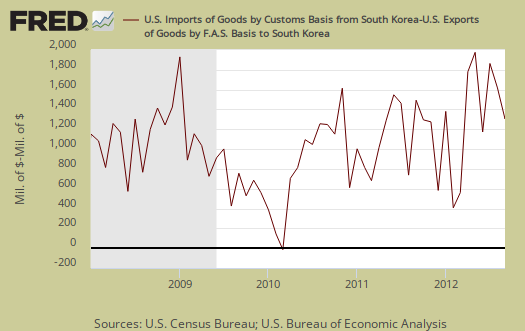
For comparison's sake, NAFTA went into effect January 1, 1994. Below is our goods trade deficit with Mexico, not seasonally adjusted. August's trade deficit with Mexico was $4.762 billion and it is 2.6 times larger than the trade deficit with Canada. Canada is the other country in NAFTA.
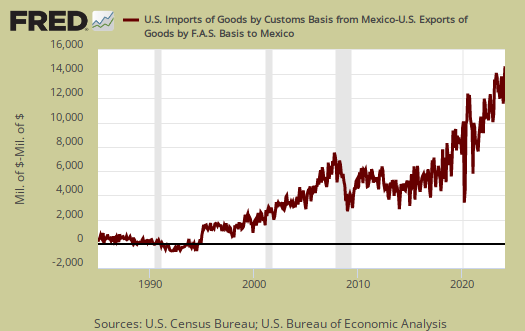
Oil or petroleum showed an end use trade deficit of $21.67 billion, for September a decrease of $1.82 billion, or -7.7%, from last month. Petroleum related end use was 38.1% of the goods trade deficit. When adjusted for prices, Petroleum related end use actually increased by -10.5%. Petroleum related imports from China as essentially non-existent.
End use means the final use of the product. For example, plastics are made up of petroleum, yet by their end use category, would be marked often as consumer goods.
The United States basically has two major ongoing problems with the trade deficit, Chinese goods and Oil imports. Below is the not seasonally adjusted import price index for oil fuel. The average price for a barrel of oil in September was $94.51.

Below are imports vs. exports of goods and services. Notice how much larger imports (maroon) are than exports (purple), but also notice the growth, or rate of change between months of U.S. exports over time. To state the obvious, imports subtract from GDP and exports add. While pundits pontificate over exports, it's the deficit that really matters when it comes to economic growth or lack thereof.

Below is another view of imports (maroon, scale on the left) against exports (blue, scale on the right). Notice the time line. Before NAFTA, 1994 we were breaking even and not running a deficit in trade. The China PNTR came into effect at the end of year 2000 and since then we are getting more trade deals passed with the claim they create jobs. Clearly that is false, as our ballooning trade deficit shows. We are exporting jobs is more the case. Politicians who claim these bad trade deals increase jobs or even increase exports are praying you never read a chart or number in your life. Else, you would see the truth, our trade deficit simply keeps growing. Only a global recession, as happened in 2008, can cause the massive trade deficit to shrink.
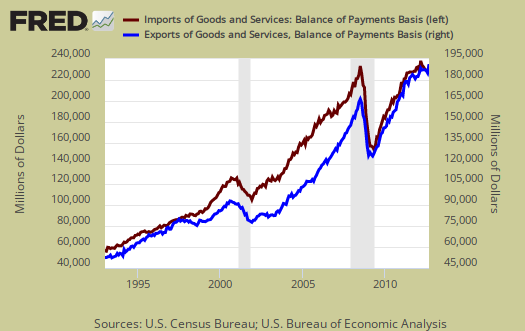
Below is another view of our trade deficit, as it grows with every bad treaty signed. The gray bars in the graph indicate recessions.

Below is the list of good export monthly changes, seasonally adjusted, by end use. The breakdown below is by the Census accounting basis, not the reported balance of payments amount and from exhibit 7. Goods exports, on a Census accounting basis, increased $5.381 billion in September. Soybean exports reversed themselves again from last month with a $871 million increase in exports. Corn exports also increased by $261 million. Industrial materials increase was due to petroleum products, other, exports, which increased $1.535 billion. These would be by-products of refineries, not in other classifications, such as wax and Petroleum coke. Nonmonetary gold exports also increased $723 million. Actual fuel oil exports also increased $610 million. Yes, we actually export fuel oil.
- Automotive vehicles, parts, and engines: -$0.289 billion
- Industrial supplies and materials: +$3.445 billion
- Foods, feeds, and beverages: +$1.138 billion
- Capital goods: +$0.432 billion
- Consumer goods: +$0.487 billion
- Other goods: +$0.167 billion
Below are the goods import monthly changes, seasonally adjusted. Overall imports increased +$3.853 billion from last month on a Census accounting basis. The story here is auto parts, which the main category has declined for two months in a row. The Obama administration filed a WTO complaint, yet there are no actual tariffs being imposed against Chinese auto parts at the moment to explain the decline beyond the political. Offshore outsourcing of auto parts manufacturing to China has resulted in a 700% auto part import increase over the last 10 years.
Another story is consumer goods and it's just unbelievable. At the top of the list for imports on consumer goods are cell phones and other household goods, n.e.c. and they increased by $1.546 billion in a month. Thanks Apple! You're adding to our trade deficit and subtracting from our economic growth!
- Industrial supplies and materials: +$1.244 billion
- Capital goods: +$0.586 billion
- Foods, feeds, and beverages: +$0.092 billion
- Automotive vehicles, parts, and engines: -$0.854 billion
- Consumer goods: +$2.650 billion
- Other goods: +$0.135 billion
Running a trade deficit in advanced technology is not a good sign for those jobs of tomorrow. The political spin is only low paying jobs are offshore outsourced. This is simply false and large sections of advanced R&D have been outsourced, along with foreign worker importation, which enables technology transfer and U.S. worker substitution. The below report statistics are not seasonally adjusted.
Advanced technology products exports were $25.8 billion in September and imports were $32.9 billion, resulting in a deficit of $7.2 billion. September exports were $0.2 billion more than the $25.5 billion in August, while September
imports were $0.6 billion more than the $32.3 billion in August.
Here is the breakdown with major trading partners, not seasonally adjusted with the parenthesis being last month's deficit figures. China is the worst trade deficit, as detailed above.
OPEC can be assumed to be oil and the OPEC nations are: Algeria, Angola, Ecuador, Iran, Iraq, Kuwait, Libya, Nigeria, Qatar, Saudi Arabia, United Arab Emirates, Venezuela. The trade deficit with Nigeria is not scams, it's oil, although considering how many financial scams originate from Nigeria, one might think so.
The September figures show surpluses, in billions of dollars, with Hong Kong $2.2 ($2.1 for August), Australia $1.9 ($1.8), Singapore $0.7 ($0.9), and Egypt $0.3 ($0.2).
Deficits were recorded, in billions of dollars, with China $29.1
($28.7), European Union $8.6 ($11.7), OPEC $7.1 ($8.1), Germany $5.2 ($5.7), Japan $4.8 ($6.7), Mexico $4.8 ($4.5), Canada $1.9 ($2.2), Ireland $1.6 ($2.4), Taiwan $1.3 ($1.4), Korea $1.3 ($1.6), Nigeria $1.2 ($1.1), and Venezuela $1.1 ($2.2).
Here is the BEA website for additional U.S. trade data, such as it is. May we suggest the Census make publicly available much more data so one can compare Apples to Apples, end use, NAICS and seasonally adjusted series. In fact, please complain to your Congressional representatives, for the Census demands $300 dollars per year to access any detail in trade statistics. That's not cool, we already pay for detailed trade statistics with tax dollars.
You might ask what are these Census Basis versus Balance of Payment mentioned all over the place? The above mentions various accounting methods so we're comparing Apples to Apples and not mixing the fruit. The trade report in particular is difficult due to the mixing of these two accounting methods and additionally some data is seasonally adjusted and others are not. One cannot compare values from different accounting methods and have that comparison be valid.
In a nutshell, the Balance of Payments accounting method is where they make a bunch of adjustments to not count imports and exports twice, the military moving stuff around or miss some additions such as freight charges. The Census basis is more plain raw data the U.S. customs people hand over which is just the stuff crosses the border. The 2005 chain weighted stuff means it was overall modified for a price increase/decrease adjustment in order to remove inflation and deflation time variance stuff.
Bottom line, you want just the raw data of what's coming into the country and going out, it's the Census basis and additionally the details are only reported in that accounting format. Additionally the per country data is not seasonally adjusted so watch out trying to add those numbers into the overall trade deficit. It's a statistical no-no to mix seasonal and non-seasonally adjusted numbers.
Here is last month's trade deficit overview, data unrevised.

Recent comments